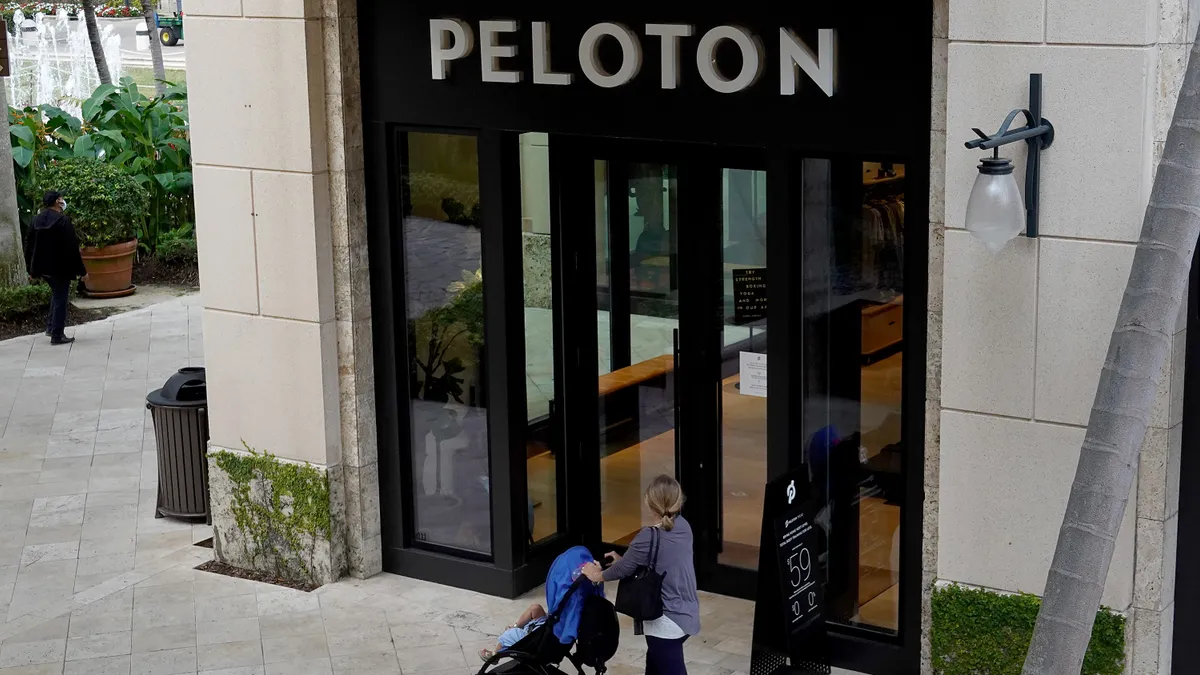What do you call a place where people can shop for a huge assortment of goods from a wide variety of sellers? Maybe they’re looking for a big-ticket item like a couch, or something small like lipstick. Maybe they need sneakers, cutlery, luggage or food — or maybe they’re just browsing.
These scenarios could unfold at a department store, a mall or the Grand Bazaar in Istanbul. But increasingly, they bring to mind an online marketplace — a digital mall of a sort that, when done right, can drive efficiencies and sales for retailers and brands alike, while giving consumers a smooth way to shop for just about anything they may want to buy.
For a while now, Amazon, eBay and Alibaba’s Tmall have been the big names in marketplaces, and it’s still true that those three alone accounted for about $365 billion in sales worldwide in 2016, or 31% of all e-commerce sales, according to global market research firm Euromonitor. And the marketplace momentum is growing: Half of all merchandise sold on Amazon's site now comes from third-party sellers.
“[Amazon Marketplace] allows Amazon to capitalize on high-volume items with strong margins, while allowing third parties to assume the risk on less popular items and keeping consumers confident in their ability to get their product from Amazon’s website,” Jenn Markey, marketing vice president at retail strategy firm 360pi, told Retail Dive. “Similarly, Wal-Mart’s recent acquisition of Jet.com highlights how strategic Wal-Mart deems their marketplace to be to the company’s future. Wal-Mart clearly intends to broaden its online assortment, appeal to more third-party sellers and accelerate the attainment of their stated ambition to add 1 million products a month to their digital shelf.”
It's no surprise that other retailers are waking up to the opportunities that marketplaces present. But they must be wary of the perils as well.
“We look at marketplaces as the new retail battleground,” Markey said. “For the retailers that embrace them, it creates an endless aisle online without the traditional costs. But even Amazon is experiencing that it can be the Wild Wild West. The challenge is that some vendors are more legitimate than others.”
Navigating the endless aisle
Amazon and Wal-Mart are general merchandisers, where customers go to find anything from laundry detergent to electronics, so it may seem obvious that both retailers (and their customers) would benefit from the additional product and price options presented by third-party sellers on their marketplaces. But specialty retailers are also increasingly creating marketplaces in order to offer customers merchandise that doesn’t quite fit their inventory or buying needs but nevertheless bolsters their core offering and brand. For example, Crate and Barrel in November announced the launch of a marketplace featuring “highly curated” items from third-party sellers — products that complement the home goods and furnishings retailer's existing merchandise mix, complete with some exclusives.
“The best retailers are the best storytellers, and they do that with the brands they work with and the products they sell,” Josh Wexler, CEO of marketplace automation platform RevCascade (which worked with Crate and Barrel to launch its marketplace), told Retail Dive. “I think that by selecting who you want to participate in your marketplace on an invitation-only basis, consumers value that curation, and the buying team at Crate and Barrel has embraced this [change]. It’s just a massive opportunity to extend their aisle that benefits both consumers and retailers and brands.”
Consumers have come to prefer these marketplaces because they offer competitive prices and a deep catalog of merchandise, according to research from Forrester commissioned by marketplace platform company Mirakl and e-commerce solutions firm ChannelAdvisor. More than 70% of consumers said they appreciate the ability to view prices from various sellers on marketplaces, and 56% said they seek marketplaces that offer a variety of products and services, that research found.
But the marketplace approach introduces new responsibilities and risks. It breaks down the traditional buying and distribution opportunities in retail, shifting them to the vendor, which is no longer guaranteed a sale and may have to take on fulfillment costs (plus the commission to the marketplace owner). At the same time, of course, those vendors gain the opportunity to leverage the brand reputation and awareness of an Amazon or a Crate and Barrel, not to mention direct access to their customer demographics.
“What companies are trying to do today is to create this digital mall experience, remembering the internal costs of creating a merchandising team, inventory management,” Forrester analyst Brendan Witcher told Retail Dive. “Whereas if you become a facilitator of sales, it’s much lower costs from an operational standpoint. It makes a lot of sense.”
That's why brands and manufacturers are increasingly turning to marketplaces to sell directly to consumers, Witcher added.
“I think the differentiator for titling something a ‘marketplace’ is 'Does the consumer become aware that they’re getting the product from an outside company?'" he said. “Otherwise, it’s just another distribution center.”
Marketplace pitfalls
For that reason, some experts argue Crate and Barrel’s approach doesn’t quite qualify as a marketplace, because customers are still essentially buying from Crate and Barrel — i.e., they don’t see the vendor that's drop-shipping the item they’re buying. Even if a marketplace is run by a department store, it should be clear that an item is being handled and shipped by the third party, according to Adrien Nussenbaum, U.S. CEO of marketplace platform startup Mirakl.
“In a traditional retail world, the retailer is the client of the supplier,” Nussenbaum told Retail Dive. “In a marketplace world, the third party becomes the client of the retailer, because they are paying the retailer a commission for the sales. There’s a new sense of service that is owed to the third parties. It’s a space online where third party sellers are able to be seen.”
That introduces a need for both cultural and technological change, experts say. “At first glance, adding a marketplace seems like an easy way to extend your brand, your reach and your base,” said Brett Wickard, founder and president of “lean retail” analytics firm Fieldstack, in an email to Retail Dive. “However, it is ridiculously more complex than it seems at first glance. Customers don’t disconnect a merchant’s brand from their experience with third-party sellers on your marketplace — problems with marketplace orders bubble up to the marketplace owner. While data shows this, you can easily see for yourself with public data. Look at almost any item on Amazon — customers of marketplace vendors often conflate their shipping or marketplace experience with the quality of the item itself.”
That can lead to problems. Electronics retailer Best Buy shuttered its five-year-old marketplace about a year ago, citing shopper confusion and other priorities.
“There are two big elements that make a marketplace successful,” said Scott Fitzgerald, marketing chief at global payment and e-commerce solutions Bluesnap, which recently boosted its marketplace capabilities for sellers that market globally. “First, they have to have a trusted brand. If consumers already trust that retailer for certain aspects of their life, they’re more likely to trust them for more — and adjacent — purchases. Amazon certainly has proven this, marching from books to toys to electronics to everything."
The second element is more subtle and technological, Fitzgerald says. "The marketplace has to make the relationship between buyer and vendor easier on the marketplace than in any other forum," he told Retail Dive in an email. "This is all about technology and experience that removes friction. In the case of a marketplace, this is both removing friction for the buyer (easy purchase process) and for the seller (how sellers get onboarded, how they get paid, reporting, etc.). Marketplaces that really succeed go after a spot where there is friction today and attack it furiously.”
Fieldstack's Wickard agrees. "Many merchants have trouble handling logistics for organic and primary fulfillment, so they lack the ability to handle the additional complexity of more third-party pieces to the fulfillment process. Successful marketplaces that enhance the merchant’s brand require an open responsive backend. Real-time or near real-time trading of fulfillment status between third parties is critical (i.e. XML, JSON, protobuf, etc.). Merchants considering bolting on a disconnected, batch-based solution to their siloed backend are likely to face difficult customer service situations that will negatively impact their brand."
Retailers like Amazon, Wal-Mart, Sears and Overstock that have created marketplaces have the IT and HR resources to build a marketplace platform and manage it internally, but most retailers don’t have those resources, says Nussenbaum. Even when they do, a marketplace can be difficult to execute and scale. Common mistakes include a lack of vendor hiring and onboarding strategy; miscommunication between internal stakeholders like merchandisers and marketers about how to promote and sell marketplace products; and a failure to prioritize the marketplace project and truly commit to it, according to Nussenbaum.
“Amazon found success when it gave its marketplace products the same amount of love as its own products,” he said, noting that the direct price competition, plainly seen on Amazon’s marketplace from all sellers (including Amazon itself), builds trust and transparency with customers.
Some of the love can be misplaced. As their marketplaces have grown, Amazon, eBay, Alibaba and artisan site Etsy, have struggled with the quality of their vendors’ products and services, particularly those selling knockoffs of favored brands. Amazon and Alibaba in recent months have lodged their first lawsuits ever against sellers they allege are listing fake goods, and Alibaba’s Taobao marketplace last month was re-listed on the U.S. Trade Representative’s Notorious Markets roster because of the number of counterfeits for sale there (as well as the difficulty brands have in getting Alibaba to address the issue).
But sellers on Amazon’s marketplace say that the e-commerce giant's zeal in cracking down on counterfeits has resulted in innocent sellers getting caught up in the fight. "Amazon has such a high quality bar that it sometimes misfires,” according to Scot Wingo, executive chairman of e-commerce solutions firm ChannelAdvisor. “The kinds of things we see are that they’re ‘Shoot first, verify later.’”
That shows what a balancing act marketplaces can be. Nevertheless, they offer opportunities for both retailers and vendors that may be too appealing and too lucrative to ignore.
“Retailers are looking at marketplaces because they’re losing the selection game — and the world is going faster,” Wingo told Retail Dive. “That’s the drive for marketplaces — it allows you to explode your selection. From the seller perspective, they want their products everywhere. Many sellers view those third-party drop ship [agreements] a lot harder to deal with, and for some, marketplaces mean all of the negatives but few of the positives. But if you want to do right by the customer, give them more stuff to buy from you.”
And that global scope and reach is something other all-inclusive shopping destinations like the bazaar, the department store and the mall simply can't match.
“We see the adoption of marketplaces hitting a next inflection point,” Fitzgerald says. “Big players like Amazon, Uber and Airbnb have led the way, and now industries of all shapes and sizes are creating specialized marketplaces. Getting global right is the name of the game to really ensure the value of the experience for both the buyer and the sellers who want to participate.”






















